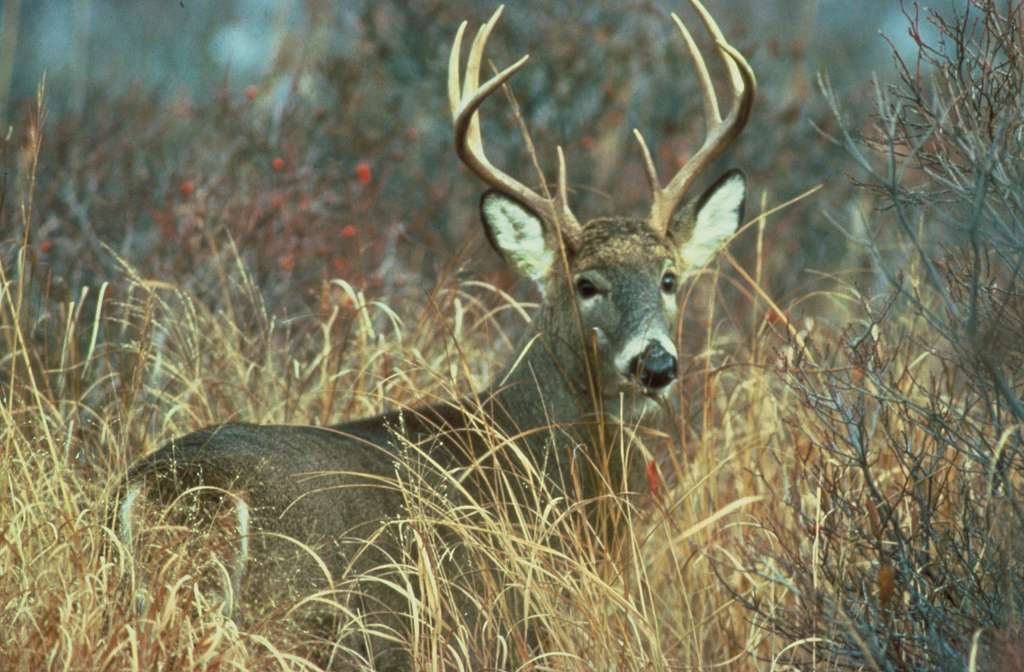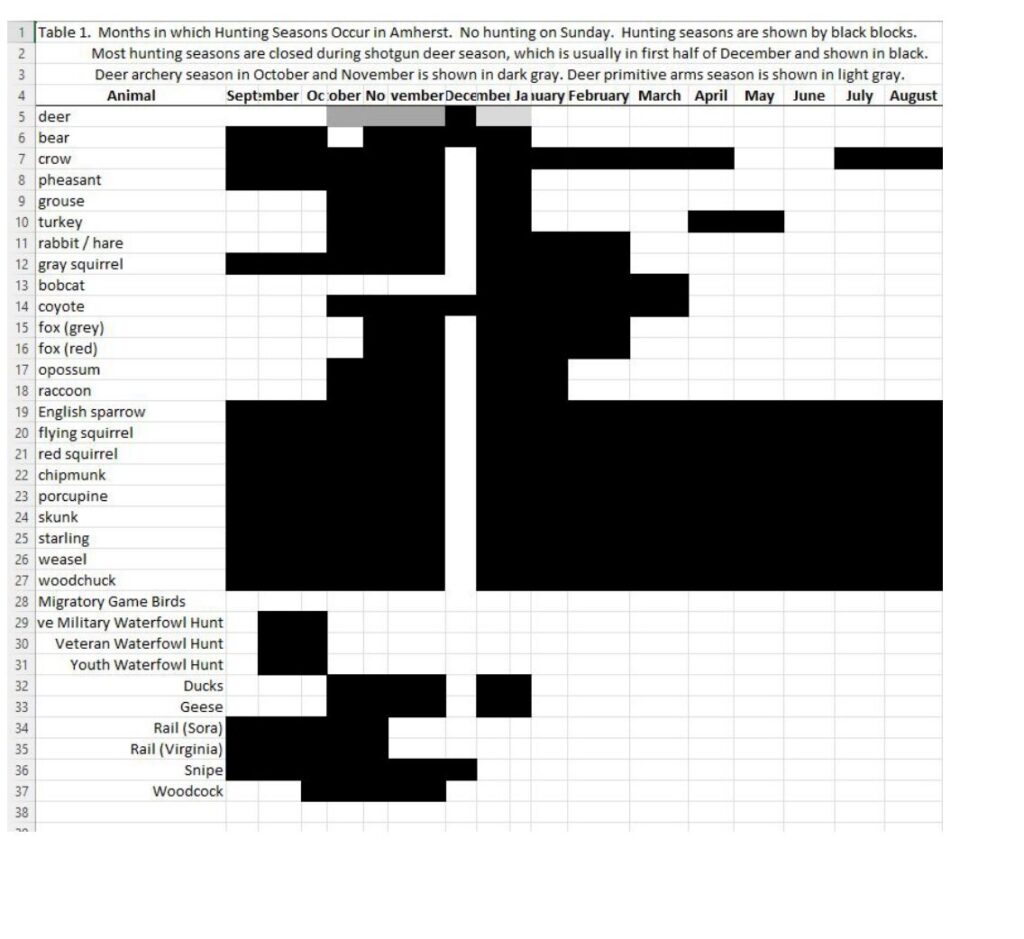Town Hunting Regulations Still Up in the Air

Photo: wtdfishwild/public domain
Report on the Special Meeting of the Amherst Conservation Commission, July 30, 2025
This meeting was held over Zoom and was recorded.
Present
Michelle Labbe (Chair), Andrey Guidera, Alex Hoar, Jason Dorney, Rachel Loeffler, and Bruce Stedman
Staff: Erin Jacque (Conservation Agent). Absent: Dave Ziomek (Assistant Town Manager)
In its report of December 4, 2024, the Land Management Subcommittee of the Conservation Commission could not agree on the status of hunting in Amherst. A subsequent discussion in April 2025 still revealed divided opinions. The subcommittee recommendation that hunting be banned on all conservation lands in town met with stiff objections from some committee members, so a special hearing was scheduled for July 30 to present alternatives to a complete ban. It, too, failed to resolve the issue.
Hunting is currently allowed on eight of 58 conservation areas in Amherst when in season. Loaded firearms are prohibited within 500 feet of a dwelling. The state permits hunting of 23 species. Local regulations are posted on the Conservation Department webpage.
In presenting the summary of the subcommittee’s report, which recommended limiting hunting, Alex Hoar noted that the population of Amherst has increased from about 7,000 to 40,000 (including college students) in the past 80 years, as has the use of the town’s more than 140 miles of trails. State law permits hunting in all areas unless posted or prohibited, according to Massachusetts Wildlife. With the 500-foot buffer around structures for firearms, he estimated that hunting would only be allowed in Amherst on seven acres, and the irregular borders of the buffer would make enforcement difficult. He also noted that if hunting of all 23 allowable species plus migratory fowl were permitted, almost the entire year would have hunting of some species permitted.
In addition to an outright ban on hunting, Hoar presented four possible compromises:
- Status quo, with hunting of 23 species allowed at the locations noted on the town website, except where barred by deed restrictions [see table below]
- Same as in 1, but limited to hunting of five species (deer, pheasant, turkey, grouse, and rabbit)
- Hunting of all allowable species with the safety buffers presented in the subcommittee report (500 feet from any structure and 150 feet from any road or the rail trail)
- Hunting limited to the five species in #2 with the above safety buffers
The counterpoint to further limiting of hunting was presented by commission member Andrey Guidera, who stated that state law allows hunting in any area that is not posted, unless it is within 500 feet of a structure for firearms or 300 feet for bows. He cited the benefits of hunting, especially in limiting the deer population, which can decimate vegetation, spread Lyme disease and other tick-borne illness, and cause vehicle collisions. He noted that wildlife biologist Martin Feehan told the commission last March that the deer population in Amherst was above the 18 deer per square mile where damage to the ecosystem occurs. He added that 45% of local deer ticks are positive for Lyme disease. In addition, Guidera stated that Feehan noted that processed venison from 312 deer were distributed to 16 nonprofit food suppliers in the state, including the Food Bank of Western Massachusetts and the Northampton Survival Center, through Mass Wildlife’s Share the Harvest program.
Guidera further bolstered his argument for not limiting hunting by noting that the 2024 Open Space survey did not show any safety concerns from the public regarding hunting. Only two comments mentioned hunting and one of those expressed the wish for more land to be open to hunting. The behavior of dogs on conservation land was a far greater concern for survey respondents. Staff liaison Dave Ziomek concurred, saying that the Conservation Department rarely hears any complaints about hunters and that he has heard only a couple in the 20-plus years he has been with the town.
According to Guidera, the reasons stated for limiting or banning hunting in the subcommittee report are safety, the Conservation Department’s mission statement, and distaste for hunting. He said that hunting is safe — the state requires a background check, a firearms I.D. (not for bows), and a hunter education course in order to obtain a permit. The only allowable implements are 22 caliber rifles (except for bear hunting), bows, crossbows, and shotguns of 10 gauge or less. In addition to the regulation that no loaded firearm or discharge of a firearm is allowed within 500 feet of a “dwelling” including a barn , no discharge within 150 feet of a road, and no shooting across a road. There is no safety buffer for hiking trails because, according to Guidera, most hunting is in the fall, when there are no leaves on the trees to interfere with sightlines.
Finally, Guidera wanted to know how the town’s regulations about hunting came into being, because none of the conservation land is posted to prohibit hunting as required by the state, so technically all land not within 500 feet of a building should be open to hunting. Ziomek said that the current local regulations have been in place as long as he has been working for the town, and that they were probably created in the 1980s. He also said he does not remember anyone questioning them until now..
Guidera then asked how the rules could be enforced if they were not created legally. “How would you charge someone for breaking a law that does not exist?” he asked, adding that information on a website is not a law. Commission Chair Michelle Labbe stated that the discussion is about regulations, not laws. Ziomek noted that the same process argument could be made for limitations on mountain biking, the hours conservation areas are open (dawn to dusk), or the rules for community gardens. He said that any changes to regulations would require a public hearing.
Commissioner Rachel Loeffler said she favored a 150-foot buffer for roads and hiking trails. Labbe thought that, in addition to the rights of hunters, the commission should consider the displacement of the public from hiking trails during hunting season because of safety concerns. Ziomek said he can recall only one safety incident involving hunting, and that was at Amethyst Brook in the 1980s.
Ziomek agreed to re-look at all town-owned conservation land in terms of availability for hunting and to think beyond deer hunting. Guidera urged him to keep an open mind and to consider the facts. Commission member Jason Dorney stated that the subcommittee’s recommendations were based “more on feelings than facts,” and said that there were no actual safety concerns with hunting. Some of the subcommittee’s safety recommendations to be considered were to post trails stating where hunting is or isn’t allowed and to encourage trail users and pets to wear orange during hunting season.
The commission agreed to continue discussing the hunting regulations. Ziomek said he would get a legal opinion about whether posting an area in which hunting is forbidden on the website is enough, or if it needs to be posted at the site. Commissioners are to direct other questions to him. A public hearing on other land management rules and regulations will probably be scheduled in the fall.


